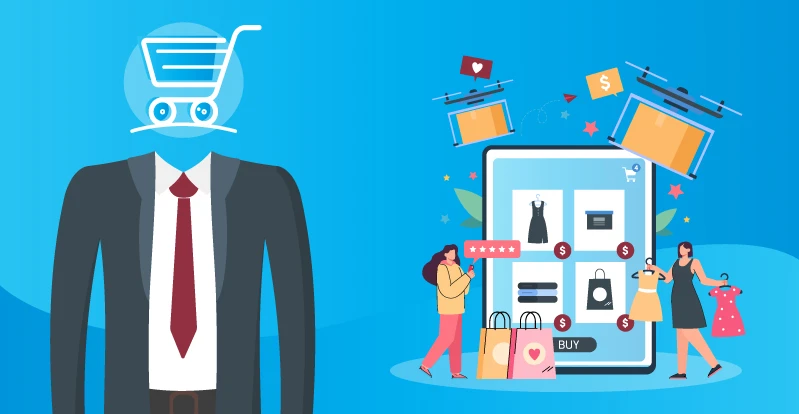Why Modern Marketers and Digital Producers are Going Headless

Today the headless trend is more than just tech vendor jargon. Headless trend is an absolute necessity for organizations, particularly those that rely heavily on a media-first, visual user experience. Adoption of headless trends is rising, and companies reap the benefits first and.
Modern marketing teams, particularly firms with a complex technological stack and many content systems, must consider how they may leverage headless trends to boost flexibility and compete in the visual economy.
It’s time to utilize headless trend content management tools. This strategy lets content authors and front-end developers utilize their languages, tools, and workflows rather than depending on a conventional CMS or ecommerce platform. JSON, a machine-readable format, is used to transmit content. Designers and developers are then given more freedom to use material wherever and whenever it makes sense.
Different programming languages, databases, and developer tools excel at various jobs, such as the materials used to construct skyscrapers and homes. A detached approach is preferable.
Because of the vast number of digital channels accessible to marketers, generating and distributing content fit for each has become increasingly complicated, making the objective of ‘write once, run anywhere’ increasingly impossible.
What is the Headless Trend?
Headless trend enables additional flexibility by linking different marketing tools, such as content and commerce campaigns. This is becoming more prominent in Headless eCommerce Solutions, where the notion was formerly known as API-driven commerce.
Today, bigger, multichannel retailers employ commerce APIs and a headless trend strategy to power their digital channels like apps, progressive Web applications, digital signage, and even IoT [Internet of Things]. In a way, going headless is already commonplace.
One notion that is keeping the dream alive is ‘headless trend’ publishing, which separates content development from publication. While the concept has been around for a while, the headless trend has lately gained traction as a way to connect diverse technology stacks. Because of the growth of channels and the necessity to smooth down delivery procedures, interest in headless solutions has lately surged. To better ensure the fundamental concept, apps may interact between the back-end and the front-end in a headless environment using services such as GraphQL.

Commerce and Headless CMS
Let’s start with the fundamentals – the standard CMS. You’ve most likely heard of Drupal, WordPress, Sitecore, and Kentico. These (and other) systems are convenient because they allow developers to produce and change content to generate a web page. They also include an in-built templating and storing system. In summary, a typical CMS provides for the storage of material, creating templates, and creating web pages.
Headless Content Management Systems begins in the same way. The system allows you to create, update, and save material and data, but where it differs from a standard CMS is in the templating. Instead of utilizing the CMS templating engine to construct the page, it is offloaded onto a different framework that is not part of the CMS. It integrates API into the main codebase to extract material from apps. So the most well-known CMS on the internet is on its way.
Developers aren’t typically creating these experiences since marketers aren’t asking for them. They are clinging to our old ways of doing things. The majority of traffic is mobile, and there are more connected gadgets than people. The technology is available.
However, any developer may utilize their API. Other Headless CMSes include Kentico, GraphCMS (built on top of the significant GraphQL project), Contentstack, Canner, Prismic, etc. “Content infrastructure” is provided by Contentful. Their API goes beyond the typical page-centric content strategy. As a result, they do not consider themselves CMS. Contentful may appear complicated at first, but it is ideal for distributing material across several platforms. Front-end developers may swiftly deploy and scale stacks in diverse environments by utilizing Heroku.
It’s past time for content creators and developers to stop getting in each other’s way. We can see now. Because standard CMSs or eCommerce business platform enable people to go headless, one can quickly deploy and edit content into any app your developers can create by becoming headless. Content can be provided in a specific area and on several devices simultaneously.
Developers may utilize your material in any form, on any device, and on a far larger scale. A/B or multivariate testing is used. Use powerful AI to personalize content for users. Personalize digital displays. Pull material from another API, arrange it, and distribute it through your digital properties.
Companies can have a centralized dashboard to import their content if developers can construct it. Since the advent of the CMS, the web has radically transformed. It’s time to go past traditional CMS thinking, much as we did when we transitioned from Dreamweaver to the CMS. The web will eventually become far more fascinating.

Traditional SaaS Application Drawbacks
The tremendous investment businesses have made in their online presence to develop user experiences that engage, convert, and foster long-term loyalty is a side consequence of the epidemic. With 84 percent of customers stating that a video inspired them to buy anything, companies need to convey pictures and videos to online shoppers.
As a result, handling rich material quickly and effectively has become essential yet challenging. Content management system (CMS) fundamentals cannot successfully organize, source, optimize, and distribute graphic assets at the scale required today.
SaaS applications have traditionally been implemented in one of two methods, both of which have substantial drawbacks:
- Best-in-class applications: Independent best-of-breed systems, despite their unique features for business processes, tend to complicate operations and create silos. Fixing the underlying issues takes time for both developers and marketers.
- Platforms with many functions: This uniform and simplified strategy allows apps to connect effortlessly. All-in-one systems, while efficient, may lack sophisticated components.
Brands can overcome these obstacles with headless apps and provide engaging experiences to their audiences.
APIs that are well-structured and a path to go for headless. Headless trends are appropriate for companies with a complex technological stack that includes various content systems, teams, and workflows. These companies benefit from having clear and well-structured APIs that effectively process media files and information.
They must have well-proven technological integrations to hold metadata alongside media assets. Businesses can effortlessly combine their other platforms and best-of-breed apps to organize, search, and manage graphics via an integrated or customized user interface.
Headless trends result in agility and customization. To stay up with the surge in media needs and consumption, businesses must have a consistent framework to manage, adapt, and deliver those assets efficiently. Headless technologies enable this by including features such as:
Scalable: Different teams may use the same content repository to design and distribute experiences across all websites, applications, and systems, assuring consistency and efficiency. In addition to being available through the primary UI, all headless trend functions may be expanded into current systems and processes, resulting in increased user adoption and an ideal single silo-less source of truth.
Flexible: With extensive APIs and SDKs, developers may use their programming language to create a bespoke interface or interact with other systems, enhancing productivity at the same time.
Agile: Using a go-for-headless design to build a best-of-breed stack enables agile replacements or upgrades to the pile, adjusting to changing business demands while incorporating new trends and technology.
Customizable: Unlike even the best-performing traditional DAMs’ one-size-fits-all approach, a bespoke UI built on APIs offers functionality that matches unique business demands.
These specific features enable firms to quickly digest various media and produce more appealing visual storytelling across several platforms. It also provides for a shorter time-to-market to fulfil customer needs.

Why Headless?
Why bother outsourcing rendering to a new system when standard Content Management Systems already render the content?
The Most Recent Front-End Technologies
The distinction between websites and web apps is becoming increasingly blurred as many frameworks designed with application-level interaction grow. These frameworks are becoming the norm because they make it easier to create and manage sophisticated real-time interactions, animations, and visualizations.
These frameworks use APIs to get data. Because of the separation of content (CMS) and display (frameworks), each system can concentrate on what it excels at. The CMS excels at content creation and data storage, and the front-end frameworks may display this data in whichever way your designers wish. The presentation layer’s open-ended character gives this idea its power and flexibility.
One Website, Several Platforms
Companies now have Constituent Relationship Management (CRM) software, an Association Management System (AMS), and various other platforms containing their many types of data. These data may be combined using APIs that interface with a headless CMS and a framework that pulls data from the CMS. This allows your data to interact fluidly, giving your visitors a better user experience.
Multiple Platforms, One CMS
You may now export data as an API with a headless CMS. This includes the ability to reuse the data for other systems that rely on it. A website, a different mobile application, and a wearable, for example, might all use the same data that you’ve previously produced. The possibilities are limitless.
Scalability Over Time
The benefit of separating data and display is that if the CMS has to be replaced or upgraded for whatever reason, the look and feel of your website may be preserved as long as the new system’s API can produce the same data as the old CMS. When the design of your senior site is functional, but the CMS is obsolete, that functionality may save you a lot of time, money, and effort.
Advantages in Performance and Security
A typical Content Management System takes much longer to generate and show a page because it has to retrieve and parse from the database (your stored content) every time. Because the data is stored in an API, a headless trend includes speed enhancements by default.
Similarly, headless trends provide security benefits. Because rendering exists outside of the CMS, there is less data that may be exploited.
What’s Driving Uptake
According to Scott Rigby, Adobe’s head of digital transformation, the adoption of the headless trend in commerce is frequently motivated by the need for increased flexibility that comes from divorcing the content management or experience layer from the commerce platform. This equates to more technological options and can also help firms who wish to update their technology stack slowly.
“Say you’re changing an experience, like a template or navigation,” Rigby explains. “You do not need to do a complete code modification. And when that change is made, no code for the experience and commerce layers is added, which slows you down.” However, the headless technique has its drawbacks, mainly when two technologies are now being employed to produce a merged experience.
“The most challenging difficulty is for creative designers since they create various components that make up an experience but may never see the whole interplay of those multiple experiences. It will look different on an Apple device, an Android smartphone, and a shop screen, “Rigby states.
According to Dunne, most firms opt for a mixed strategy rather than becoming completely headless.
For certain businesses, being headless puts the onus on them to be delivery developers when they don’t need to be. “If you will be pure-play headless, meaning without other methods to retrieve and deliver and present, then you are institutionalizing the need for ongoing development for endpoint technology.” It’s evident that the Headless trend is here to stay, and large businesses are migrating their web presence to this framework to empower content producers, create better experiences for their consumers, and efficiently handle Omni channel messaging.
As you can see, there is no one-size-fits-all solution or CMS for every use case – but we believe that removing the display layer of your content and making it available for more than one platform if necessary is the way to go! You can reuse your material more simply, but you won’t have to worry about your content if you alter your technological stack.


